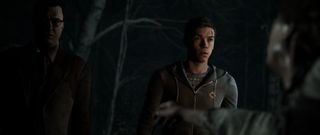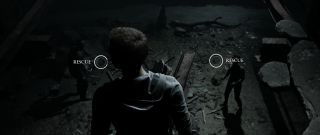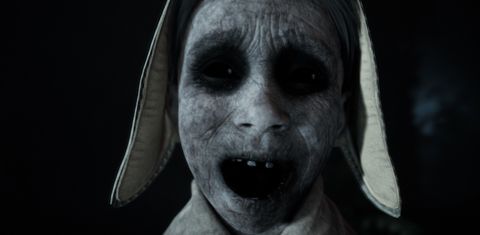Our Verdict
Not quite as novel as its predecessor, but the co-op is still bewitching.
PC Gamer's got your back
What is it? The second part of a horror anthology, this time set in a town with a history of witchcraft
Expect to pay £25/$30
Developer Supermassive Games
Publisher Bandai Namco
Reviewed on GTX 1080 Ti, Intel i7-8086K, 16GB RAM
Multiplayer Yes
Link Official site
Cerebral, psychological horror is fine, but I like my scares to come from monster chases and stuff jumping out of the shadows. Idiots in peril, abandoned towns, maybe some supernatural shenanigans—that's where I get my thrills. Little Hope, the second game in Supermassive's Dark Pictures Anthology, has all of that, along with multiplayer modes that let it simultaneously capture the experience of watching and being inside a goofy horror flick with your pals.
Like its predecessor, Man of Medan, it's through the cooperative modes that the game really reveals all of its mysteries. In singleplayer, you'll control different members of the a quintet, trapped in the haunted town of Little Hope by a seemingly magical fog and plagued by visions of 17th century witch trials. In the shared story, however, you'll get an opportunity to experience these scenes from a different perspective, as well as having to rely on your co-op buddy when the group splits up, listening to them as they investigate ruined buildings or get ambushed by a monster.
I've been on both sides—the person listening and the person being attacked—but I'm struggling to pick which is more stressful. Listening to a friend being mauled really might be worse. You might be so far away that you can only listen to your friend panicking, unable to leap to their aid. In some cases, though, you'll get an opportunity to intervene, but that could be even worse. What if you mess up the quick time event and make a complete arse out of yourself? What if it's your fault that they're dead? That's going to put a real strain on the relationship.

The frantic QTE action sequences made me feel like I was always just about to die, but they're actually quite easy going. To make them more accessible, Supermassive has added unobtrusive alerts ahead of the prompts, not just warning you that a QTE is coming, but letting you know what type of action you'll be doing. Jumping, attacking, shooting—they all have their own icon. This extra second to prepare doesn't diminish their impact, but it does make it less likely that you'll hit the wrong button just because you were surprised. Even if you do fail a QTE, you'll usually get a few opportunities to get the upper hand or escape, so one mistake won't result in your death. And that's why I was able to forgive my co-op buddy for all the failed rescues.
Little Hope is a social game. You can enjoy it on your lonesome, but you'll miss out the best parts. You're meant to yell, throw out theories about why the gang is trapped and develop these characters together. After every surprise or near death experience, I found myself hitting pause so we could talk about what just happened and build the full picture from our individual perspectives. This was the magic that made Man of Medan work, too, and good co-op can make it easy to overlook places where the game is less refined. But Little Hope doesn't really develop it further, and it actually takes advantage of it less.
Man of Medan's themes of paranoia were reflected in the co-op. You could, for instance, be standing in exactly the same room at the same time but actually seeing slightly different things. It sowed doubt and distrust. Little Hope has a more ambitious narrative, with different timelines and a more complex mystery to unravel, but that hasn't resulted in the kind of novel co-op tricks or twists that we saw in the last game.

There's still drama and plenty of conflict between the characters, mind you. The gang is made up of three students in their 20s, a mature student and their professor. Two of them are secretly dating, but nobody really gets along that well in Little Hope. They're stressed, but they're also just kinda dicks, with one bland exception. They're familiar archetypes, like the vanilla do-gooder, the tense academic and the Karen. Being painted in such broad strokes makes it easier to slip into their personalities when you take control of them, though, and while none of these characters are particularly nuanced, most of them are fun roleplaying subjects.
It's Angela, the Queen of Karens, who ends up being the most memorable. She is, entirely unexpectedly, great. Well, no, she's terrible, but she's a lot of fun to play. Within a few minutes of meeting her, you learn that she's planning on suing the university because their bus crashed, she absolutely despises the only other woman in the group (and the implication is that this is the case with most women), she has an unrelenting hunger for boy flesh and she's got a cutting remark or insult for every occasion.
The bitter spinster is a tired trope, but Angela rules. I've thoroughly enjoyed calling everything and everyone bullshit on this harrowing adventure. She will gladly tell off a ghost, or follow up a traumatic event by putting some of her companions down. She's had it up to here with these damn kids and these damn ghosts. She did, I should add, improve over time, and when I finished my playthrough, everyone in the gang was willing to die for one another. It's a short game, clocking in at around four hours, but a lot of living, and a lot of dying, is squeezed into that time. The culmination of my choices was a third act full of heroic moments and the gang going toe-to-toe with their supernatural hunters. You can forge this ragtag group of students into a bunch of real badasses. If you can keep them alive.


Like Man of Medan, Little Hope features two multiplayer modes, and if you only play it once, you should definitely do it with friends.
Shared Story
The Shared Story mode lets you play online with one other person. Like the singleplayer mode, both of you will get opportunities to control every character. For about half of the game, you'll be split up, passing information back and forth, but you'll also need to work together to overcome obstacles and kick the shit out of some monsters.
Movie Night
Movie Night mode is an offline multiplayer mode that lets you play in a group of five. You pass the controller around depending on who's character is in play, and like the Shared Story mode you'll get to see what everyone's doing when the group splits up.
Between the QTEs and conversations are plenty of opportunities to explore, mostly by looking at objects the game clearly highlights. The camera has been freed up to give you more control as you wander around, letting you get a better look at the derelict, obviously haunted buildings that you keep breaking into. While there's not much in the way of conundrums, Supermassive uses the time to build up to some nasty surprises and tease some hints about what's really going on. Having another person to talk through your discovery with makes it feel like you're peeling back an elaborate mystery, even if you're really just clicking on a book or a photograph.
Sometimes its cinematic notions get the better of it, however, and the camera abruptly switches to a dramatic angle, like you're being watched from some bushes. Perfectly fine for a movie, maybe, but every single time this happened, my co-op partner and I stopped in our tracks because we thought we'd hit a cutscene. There are quite a few awkward scene transitions, too, or places where the pace ramps up so quickly—and awkwardly—that it's not clear what the heck is going on.
Most of the time, though, it's like being stuck in a schlocky but endearing horror movie. On the surface it's played straight, with little humour to break the tension, but really it revels in the absurdity of it all. It's Final Destination meets The Crucible, where you're watching yourself die one minute and attending a dimly lit witch trial the next. While it doesn't really expand on Supermassive's experiments in Man of Medan, it's still an entertaining co-op romp and perfectly timed if you're looking for a game to play this Halloween.
Not quite as novel as its predecessor, but the co-op is still bewitching.

Fraser is the UK online editor and has actually met The Internet in person. With over a decade of experience, he's been around the block a few times, serving as a freelancer, news editor and prolific reviewer. Strategy games have been a 30-year-long obsession, from tiny RTSs to sprawling political sims, and he never turns down the chance to rave about Total War or Crusader Kings. He's also been known to set up shop in the latest MMO and likes to wind down with an endlessly deep, systemic RPG. These days, when he's not editing, he can usually be found writing features that are 1,000 words too long or talking about his dog.
